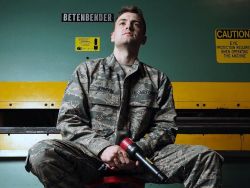JOINT BASE ELMENDORF-RICHARDSON, Alaska, June 2, 2017 — Air Force Airman 1st Class Lukas Johnson joined the Air Force to save lives. He thought he could pursue his calling sealed snugly inside a bomb suit, defusing improvised explosive devices as an explosive ordnance disposal technician.
Air Force Airman 1st Class Lukas Johnson, an aircraft structural maintenance technician with the 3rd Aircraft Maintenance Squadron at Joint Base Elmendorf-Richardson, Alaska, works with a C-130 Hercules leading-edge training aid April 20, 2017. The Phoenix native works to prevent aircraft corrosion, which can compromise an aircraft's structure. Air Force photo by David Bedard
 Air Force Airman 1st Class Lukas Johnson, an aircraft structural maintenance technician with the 3rd Aircraft Maintenance Squadron at Joint Base Elmendorf-Richardson, Alaska, works with a C-130 Hercules leading-edge training aid April 20, 2017. The Phoenix native works to prevent aircraft corrosion, which can compromise an aircraft's structure. Air Force photo by David Bedard EOD was the job listed on his original enlistment contract, but the Phoenix native was disqualified during medical screening.
Air Force Airman 1st Class Lukas Johnson, an aircraft structural maintenance technician with the 3rd Aircraft Maintenance Squadron at Joint Base Elmendorf-Richardson, Alaska, works with a C-130 Hercules leading-edge training aid April 20, 2017. The Phoenix native works to prevent aircraft corrosion, which can compromise an aircraft's structure. Air Force photo by David Bedard EOD was the job listed on his original enlistment contract, but the Phoenix native was disqualified during medical screening.
Fortunately for the 3rd Maintenance Squadron airman assigned here, he found his calling in aircraft structural maintenance, a career field charged with maintaining and repairing the sheet metal, tubing and composites that make up an aircraft fuselage.
Instead of saving lives by manually detonating artillery rounds strung together on the side of a road, Johnson defuses structural problems that could cause a catastrophic failure in flight.
“I wanted to go out there and make sure people who are deployed are always going to get back to their families," Johnson said. "Nobody is going to have to live without that one person in their lives. So, for me, it was either going to be law enforcement or joining the service.”
Details Matter
Johnson said aircraft structural maintenance can be a mix of precision work involving nanometer-level measurements and "grunt work," such as punching out stuck fasteners with a hammer. All the effort ensures aircraft are ready to fly safely.
“It's a big deal what we do every single day,” he said. “If we don't do a repair quite right, or if we don't install a D-ring quite right, … then you have a tank rolling around inside a C-17 [Globemaster III] at 36,000 feet. Everything we do has massive repercussions.”
The hangar where Johnson works looks like a massive auto body shop, as clean and orderly as a service center for supercars. But instead of patching up Ferraris and Maseratis, Johnson works with a veritable catalog of aluminum, titanium and carbon fiber to keep Air Force birds in safe defiance of gravity. Consequently, his language can often sound rather arcane.
“If we get a tech data for a C-12 [Huron], all of our guys know how to work [in a] sheet metal shop,” he said before spewing a barrage of jargon. “If they say, 'We need something at a 45-degree bend with a temper of 2024-T3 aluminum,' we can go out there and do that.”
Though his section works with some of the most technologically advanced aircraft in the world, a lot of what Johnson does may resemble what a medieval armorer did centuries ago. The primary difference is found in how exacting the airman has to be in fabricating a part that precisely matches the factory original.
Johnson described what happens when a customer unit asks for a replacement part. “They will come in, slap something down with different angles, different bends, and say, 'We need this part,'" he explained. "We head over to our sheet metal side, take measurements, do what we do, bend it up and make it new. We make things that didn't exist.”
Corrosion Control
One of the most critical parts of Johnson's job, he said, is supporting the 3rd Wing's corrosion prevention and control program. Corrosion can infiltrate the structure of an aircraft through rivets and screws.
During a recent job involving the cargo ramp of a C-17, Johnson said, he had to take great care to remove rusted rivets. Most of the fasteners -- about 60 in all -- came out easily enough with the help of a pneumatic rivet gun, he said, but one fastener refused to budge.
Airman 1st Class Lukas Johnson is an aircraft structural maintenance technician with the 3rd Maintenance Squadron at Joint Base Elmendorf-Richardson. The Phoenix native works with sheet metal, carbon fiber and paint to maintain aircraft structures.
 Airman 1st Class Lukas Johnson is an aircraft structural maintenance technician with the 3rd Maintenance Squadron at Joint Base Elmendorf-Richardson. The Phoenix native works with sheet metal, carbon fiber and paint to maintain aircraft structures. Quite suddenly, a precision job turned into grunt work. It took hours of work with a 4-pound drill hammer and a slew of broken punches before he decided he had to find a different way.
Airman 1st Class Lukas Johnson is an aircraft structural maintenance technician with the 3rd Maintenance Squadron at Joint Base Elmendorf-Richardson. The Phoenix native works with sheet metal, carbon fiber and paint to maintain aircraft structures. Quite suddenly, a precision job turned into grunt work. It took hours of work with a 4-pound drill hammer and a slew of broken punches before he decided he had to find a different way.
"I was sitting there for hours, just hitting this thing and hitting this thing,” Johnson explained with resignation in his voice. “It was an insane amount of effort we had to go through."
Johnson had to use a drill to bypass the rivet, grinding it with a Dremel tool to finally get it loose.
"A lot of it is finesse," Johnson said of his job. "A lot of it is dedication. This was a little bit of both."
Air Force Master Sgt. Richard Mabry, 3rd Maintenance Squadron aircraft structural maintenance section chief and native of Grand Forks, North Dakota, commended Johnson's efforts during the C-17 repair. He said the quality of his section's work is a matter of pride in terms of appearance and safety for anything with an "AK" emblazoned on the tail.
“These are aircraft flying around with the Alaska tail,” Mabry said, noting the meticulously applied paint that protects from infiltrating moisture. "That's our handiwork on display, but it doesn't just look nice. It's for corrosion protection."
Johnson may not have to stare down a rigged roadside mine from behind the visor of a green bomb suit, but the rusted rivets he extracts can be just as dangerous without his care. He joined the Air Force to save lives, and he does it every day.






